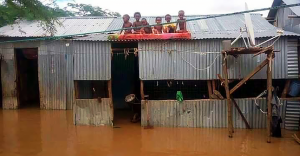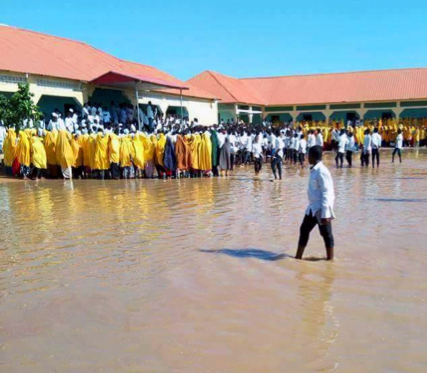Pilot Study Brings Insights About How Drought Affects Somali Schools
Monica Dashen

The schools closed down three weeks after the end of the survey due to severe flooding. Children are on the top of a home to escape the flood water.
Somalia, located on the horn of Africa, has been undergoing a widespread drought for years, creating food and water shortages. Food is available through the World Food Program (WFP), but the supply and distribution are limited. Likewise, clean water is available, but is often inaccessible due to costs and security issues. As a result, people sometimes drink unclean water and outbreaks of cholera, a water-borne disease, occur.
Data about how the drought has affected schools is sorely needed. Are the children receiving lunches? Is there a working water source? Is bleach available? Are children washing their hands with antibacterial soap? How many schools are closed? Are the existing schools overcrowded? Are the children absent for more than five days?
Until recently, the exact number of schools and pupils was unknown. A recent UN-commissioned report documented all schools in South Central Somali (SCS), with the exception of the Mogadishu area. The present work builds on this report by looking at school closures; sanitation conditions; enrollment changes; and water, food, bleach, and clinic availability during the drought.
The Study
To understand the situation, Asha Siyad of the Somali Women’s Leadership Initiative (SWLI) and I conducted a pilot phone survey of 10 head schoolmasters in charge of private, public, and internally displaced persons (IDP) camps primary schools. These schools were located in the capital district of the Hiraan region. This district is about 240 miles north of Mogadishu and sits in a valley flanked by a river. There are 192 primary schools there.

Children listen to their instructors at this flooded Somali primary school that was in the pilot study.
The interviewer first asked about the schoolmaster’s personal water, food, and bleach accessibility and costs. Then, the interviewer asked about the schoolmaster’s school, including questions about student enrollment and school thefts, along with meals and sanitation supplies. The interview took 10–15 minutes with up to three call backs.
Simply measuring the problem was not enough, however. We wanted to end the interview in a positive manner. To do so, the interviewer read aloud a set of Center for Disease Control (CDC) sanitation tips. In the pilot, we learned students washed their hands with ash. When soap is not available, ash is a viable option, so we included ash as an alternative later.
Fearing the schoolmasters may be reluctant to talk to us, we first asked permission from their sponsors to talk to them. It helped that the interviewer was familiar with the sponsors and schools. We are aware that this may influence our results, but it was the only way it could be done.
Another fear was that the schoolmasters might inflate the amount of aid or enrollment counts to garner more aid. We wanted to confirm the schoolmasters’ reports with parents of school-aged children, but this was not possible since the school head was reluctant to give us parent contact information. In-person interviews were not possible. As result, we decided to focus on presence or absence of aid, rather than quantity.
The Results
The pilot results were insightful. The schoolmasters provided thoughtful answers. In their personal lives, many school schoolmasters reportedly had access to food and water. The food was denoted by WFP and UNICEF, but not systematically. Water costs about 3 cents, and guards maintain the water supply. One person reported the water was not safe. Also, bleach was available and costs about 2 cents. No one reported accessibility to health and feeding clinics.
In their professional lives, eight schoolmasters reported overcrowded schools with students absent for more than five days. Two schoolmasters said the drought and floods reduced student enrollment. All 10 schoolmasters had working latrines and water sources. Bleach was available. Students washed their hands regularly. Food, food covers, and cooking stoves/fires were not always available. Only five schoolmasters reported receiving educational supplies within the last three months. Up to two guards secured the schools, and there were three reported attacks/thefts. When asked for additional thoughts, the interviewer and schoolmasters said there were not enough food, sanitation supplies, and janitors. To quantify the “not enough” comments, we plan to ask more detailed questions about the bleach and food supply in a scaled-up version of this survey.
After wrapping up the pilot study, the interviewer asked us for flood victim tips, as one of the schools had recently flooded. I was delighted to receive this request, as this is what the survey is about—spreading the word about what to do in an emergency. I quickly sent the interviewer Red Cross and CDC flood victim information provided by CDC officials. These tips proved to be timely. Three weeks after the end the survey, the schools were evacuated due to flooding. In the scaled-up version of this survey, we might include flood assessment knowledge questions.
Future Work
To scale up to include more regions in South Central Somalia—including the Banadir region, where Mogadishu is housed—we will need a list of schools. One possible list pertains to registered schools. Here the Minister of Education asked all school officials to register their schools with his office. This effort has been successful to the extent that school officials are willing to cooperate, as it is not mandated. Another more complete list involves the UN’s list of all canvased schools. This list involved contacting all schoolmasters identified through social media or informants.
Neither frame nor list is available to us. Undeterred, we plan to randomly select one district per region and document a set of schools from which we randomly select a schoolmaster to call. Unfortunately, the drought has spread throughout SCS, so any comparisons between drought and non-drought areas are not possible. However, comparisons can be made between rural and urban areas, as schools in urban areas have more support. The results of the scaled-up version of this survey will be sent to aid officials.
Monica Dashen retired early from the federal government and enjoys applying her skills to humanitarian pro-bono projects. For any questions or additional information, contact her at marielee43@gmail.com.

















